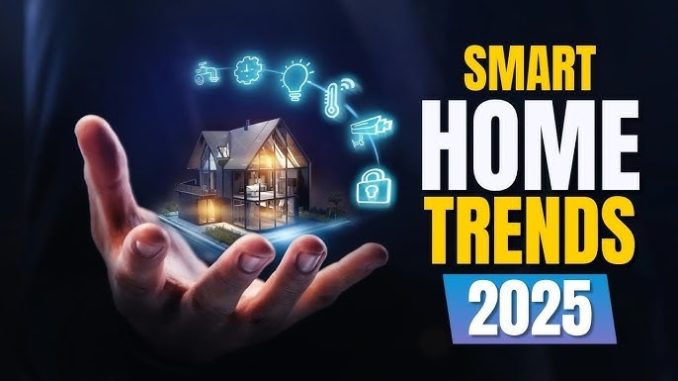
The dream of a truly intelligent home, one that anticipates needs, optimizes comfort, and seamlessly manages daily routines, is no longer confined to the pages of science fiction. As we navigate through 2025, the landscape of home automation is evolving at an exhilarating pace, driven by a convergence of technological advancements that are making our living spaces more intuitive, efficient, and interconnected than ever before. These top trends are not just about adding individual smart gadgets; they represent a holistic transformation towards truly responsive and personalized domestic environments.
At the forefront of this evolution is the pervasive integration of **Artificial Intelligence (AI)** into virtually every facet of home automation. AI-powered smart assistants, transcending the basic voice commands of yesteryear, are becoming increasingly sophisticated and predictive. These intelligent systems learn individual habits, preferences, and routines over time, enabling them to automate tasks with remarkable foresight. For example, a smart thermostat might not just respond to a voice command, but proactively adjust the temperature based on predicted weather patterns, the household’s typical schedule, and even the occupancy of different rooms. Similarly, intelligent lighting systems can adapt brightness and color temperature based on natural light, time of day, and the specific activities occurring in a space, all without explicit instruction. This deep personalization, driven by AI’s ability to process and interpret vast amounts of behavioral data, is making homes truly “smart” in a way that feels natural and effortless.
Complementing the rise of AI is the relentless pursuit of **seamless interoperability and universal connectivity**. For too long, the smart home market has been fragmented by proprietary ecosystems, requiring multiple apps and hubs to manage devices from different brands. However, 2025 marks a significant acceleration in the adoption of open standards like **Matter**, championed by major industry players. This initiative aims to unify diverse smart home devices under a single, cohesive protocol, enabling seamless communication regardless of manufacturer. The impact of this trend is profound: it simplifies setup, reduces compatibility headaches for consumers, and fosters a more integrated and user-friendly smart home experience. Imagine a smart light from one brand effortlessly communicating with a smart lock from another, all controlled through a single, intuitive interface. This push towards universal compatibility is crucial for mass adoption and for unlocking the full potential of interconnected living.
**Enhanced home security**, augmented by advanced AI and sensory technology, is another pivotal trend shaping 2025. Traditional alarm systems are giving way to intelligent surveillance networks that offer far more than simple motion detection. AI-powered cameras can now differentiate between pets, passing vehicles, and genuine intruders, significantly reducing false alarms. Features like facial recognition for trusted visitors, behavioral pattern detection (e.g., someone lingering unusually long near a window), and real-time threat analysis are becoming standard. Beyond cameras, smart locks with biometric access (fingerprint, facial recognition, or even voice authentication) provide unparalleled security and convenience, eliminating the need for physical keys. These systems often integrate seamlessly with other smart home elements, automatically turning on lights or sending alerts to neighbors or emergency services upon detecting a threat, creating a comprehensive and proactive security shield.
The growing global emphasis on sustainability and cost savings is driving a significant trend towards **energy management and eco-conscious smart home solutions**. Smart thermostats have long been a staple, but their capabilities are expanding to integrate with weather forecasts, grid demands, and personalized energy consumption patterns to optimize heating and cooling with remarkable precision. Beyond climate control, smart plugs monitor the energy consumption of individual appliances, intelligent lighting systems automatically dim or switch off in unoccupied rooms, and smart irrigation systems adjust watering schedules based on real-time weather data. The integration of smart home systems with residential solar panels and battery storage solutions is also gaining traction, allowing homeowners to maximize self-consumption of renewable energy and even feed excess power back into the grid, significantly reducing utility bills and carbon footprints.
Finally, the home is becoming a hub for **health and wellness monitoring**, with an increasing array of smart devices designed to promote well-being. Wearable technology, once primarily for fitness tracking, is now seamlessly integrating with home automation systems to monitor vital signs, sleep patterns, and even air quality. Smart beds can track sleep cycles and adjust firmness, while AI-powered air purifiers automatically activate based on detected allergens or pollutants. Some advanced setups are even exploring passive monitoring for elderly residents, detecting falls or unusual activity patterns to alert caregivers. This integration of health data into the smart home ecosystem empowers individuals to take a more proactive role in managing their well-being and provides peace of mind for families.
As we look at the trajectory of home automation in 2025, it’s clear that the future lies in systems that are not just automated, but truly intelligent, seamlessly integrated, secure, energy-efficient, and deeply personalized. The focus is shifting from discrete gadgets to cohesive, adaptive ecosystems that intuitively respond to our needs, transforming our homes into active partners in enhancing our daily lives. The ongoing convergence of AI, universal connectivity standards, and a consumer desire for convenience, security, and sustainability promises an exciting and increasingly intelligent future for our living spaces.